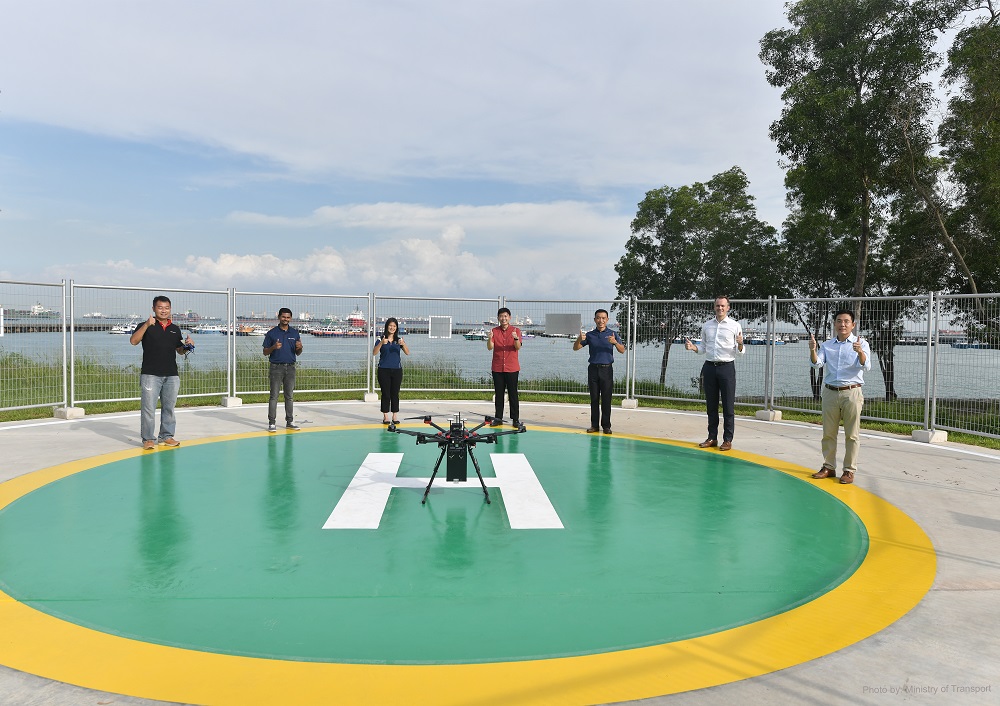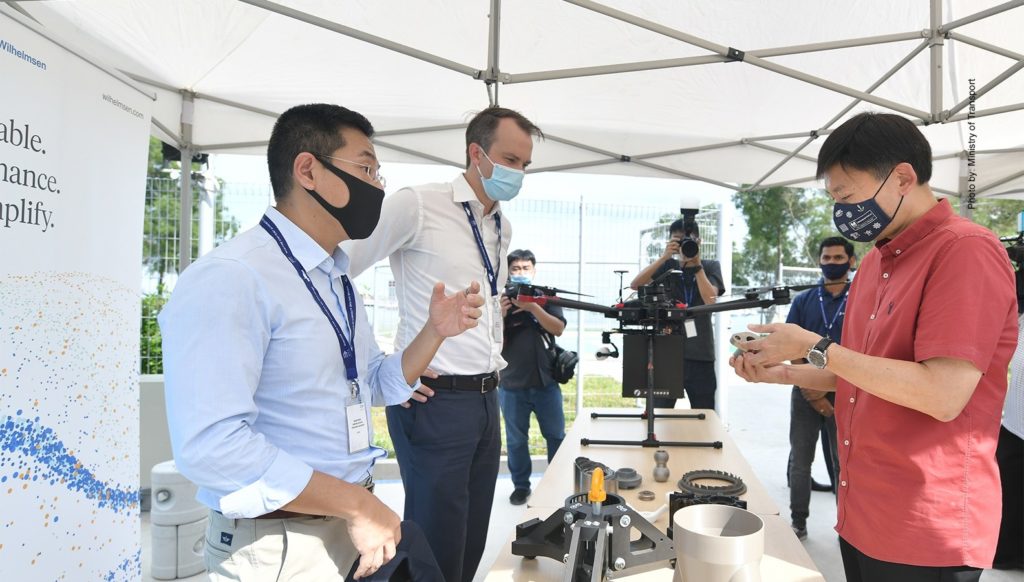One of the few businesses tackling the world of maritime 3D printing is Wilhelmsen, one of the largest businesses in the maritime sector, along with its partners, such as steel conglomerate thyssenkrupp and Wilhelmsen spin-out Ivaldi. The group’s current strategy is using additive manufacturing to produce spare parts, and to get those parts out to customers at sea they’ve deployed some unique methods. In particular, they’ve teamed up with Singapore startup F-Drones to fly them out to their clients.
The partners demonstrated this capability when serving the MMA Offshore on behalf of Kawasaki Heavy Industries. During the Maritime Drone Estate Launch in Singapore, the partners digitized, printed, tested and delivered a cooling water pipe connector to MMA Offshore’s vessel, MMA Monarch.
 The 3D printed cooling water pipe connector. Image courtesy of Wilhelmsen.
The 3D printed cooling water pipe connector. Image courtesy of Wilhelmsen.So far, the Wilhelmsen-thyssenkrupp AM fulfillment platform serves over 3,000 vessels from different locations globally. The ability to 3D print replacement parts for the marine sector has many of the same benefits that 3D printed spares have for businesses generally, and then some. The reliance on a digital inventory makes it possible to get components that are out of production and reduce the quantity of extra items an original equipment manufacturer (OEM) must manufacture in order to serve clients in the aftermarket space. This, in turn, reduces supply chain costs and delivery times. When it comes to getting these components to customers at sea, drones don’t have the same carbon footprint that other delivery options have, thus offering a potentially more sustainable solution to part delivery.
The cooling water pipe connector was first tested for quality assurance by the DNV-endorsed Quality Assurance Framework. DNV is the world’s largest classification society and has become the go-to group for certification and testing of 3D printed parts in the maritime industry.
 A drone used to deliver the 3D printed part. Image courtesy of Wilhelmsen.
A drone used to deliver the 3D printed part. Image courtesy of Wilhelmsen.The part was developed by the Wilhelmsen-led Joint Industry Program on Additive Manufacturing in Singapore consortium, which received funding from the Maritime and Port Authority of Singapore under its Maritime Innovation and Technology Fund. Among the consortium’s members are OEMs like Wärtsilä, Kawasaki Heavy Industries and Hamworthy pumps, along with DNV, thyssenkrupp, Ivaldi Group and Tytus3D, as well as end users who are already involved in Wilhelmsen’s 3D printing program.
Wilhelmsen and thyssenkrupp step-up collaboration with 3D printing joint venture from Wilhelmsen group on Vimeo.
“Additive and on-demand manufacturing is a unique opportunity for MMA Offshore and solves many of the supply chain challenges we encounter as marine operators. The ability to print and deliver spare parts on demand results in a far more effective and efficient supply chain. MMA Offshore is a proud customer of the 3D printing program by Wilhelmsen and thyssenkrupp, and we are looking forward to increasing the adoption of AM parts through this partnership across our fleet,” said Greg Reece, General Manager of Strategy & Innovation at MMA Offshore.
Kawasaki Heavy Industries is a large and important member to adopt this unique model for delivering spare parts. One of Japan’s three major heavy industrial manufacturers, Kawasaki is a $12 billion company by revenue that operates across a number of industries in addition to shipbuilding, such as aerospace, motorcycles, engines, and military.
“Additive manufacturing offers clear benefits in performance, lead time and enables a more resilient and greener supply chain. We are proud to be working with the Wilhelmsen thyssenkrupp venture, the AM market leader for the marine industry. The successful production and delivery has established a solid foundation for a future collaboration between Kawasaki Heavy Industries and the Wilhelmsen thyssenkrupp venture,” said Atsushi Ogura, Leader of AM Project Marine Machinery at Kawasaki Heavy Industries.
Having already established a consortium dedicated to 3D printing and delivering spares in the maritime sector, with Singapore the headquarters for this collaboration, competitors will have to build a substantial network in order to rival the shipping giant. Who that competitor might be is still to be determined.
Subscribe to Our Email Newsletter
Stay up-to-date on all the latest news from the 3D printing industry and receive information and offers from third party vendors.
You May Also Like
3D Printing Unpeeled: New Arkema Material for HP, Saddle and Macro MEMS
A new Arkema material for MJF is said to reduce costs per part by up to 25% and have an 85% reusability ratio. HP 3D HR PA 12 S has been...
3D Printing News Briefs, January 20, 2024: FDM, LPBF, Underwater 3D Printer, Racing, & More
We’re starting off with a process certification in today’s 3D Printing News Briefs, and then moving on to research about solute trapping, laser powder bed fusion, and then moving on...
3D Printing Webinar and Event Roundup: December 3, 2023
We’ve got plenty of events and webinars coming up for you this week! Quickparts is having a Manufacturing Roadshow, America Makes is holding a Member Town Hall, Stratafest makes two...
Formnext 2023 Day Three: Slam Dunk
I’m high—high on trade show. I’ve met numerous new faces and reconnected with old friends, creating an absolutely wonderful atmosphere. The excitement is palpable over several emerging developments. The high...
































